Rondeau Harbour to Port Colborne
Lake Erie
Monday, June 27 and Tuesday, June 28
I actively encouraged another early start to our fourth day out from Bayfield, and Captain Roland reluctantly obliged. From our anchorage in Rondeau Harbour, high clouds streaked across a pastel-colored sky, and a summer-hike layer of ground haze muted the nearby shoreline.
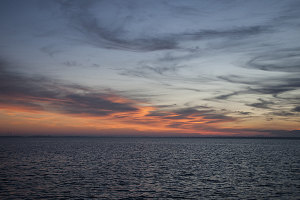
courtesy RHanel
Morning at Rondeau, Hatch View
Roland did some nav chart consulting, soon reporting that there wasn't much in the way of safe [natural] anchorages along the relatively featureless northern shore of Lake Erie. There were a few built-up ports, but Roland wasn't too keen on staying in a marina, preferring instead to find a natural (and free) anchorage. Or, at the very least, a free pier.
In any case, it was too early to decide our stopping point for the night. We would first see how good our progress was, and then project forward in time to a potential stopping point.
We fired up the motor and slowly cruised out of the harbour, back into Lake Erie. Given our recent engine troubles, I was paying slightly closer attention to the instrument cluster as we were motoring a short way out into the lake in preparation for sail unfurling. I noticed that the coolant temperature gauge seemed a bit high - higher than its usual high mark and certainly quite high given the short time that we had been running the motor. As we watched, it kept creeping higher and higher, and was soon starting to approach the red mark at about 212F (100C). Clearly something was wrong - our engine troubles were still with us. As we were in position for sailing, we cut the engine and raised the main and jib, relegating the engine problem to the backburner for the time being.
We continued our journey east along Lake Erie. Today's wind was coming from the west-southwest, and given our course, this means it was pushing on us from nearly directly astern. On first thought, you might think that this is the optimum for maximum forward sailing progress, but apparently this is not so. Instead, a wind directly from either side is more appropriate. Bernoulli's principle gets involved to make that so.
Having a tailwind was by no means an unworkable situation, however, and Roland broke out an unusual configuration that I have not seen before called wing-on-wing. Essentially, the jib and the mainsail are deployed to opposite sides of the boat, to maximize catchment of the wind without having the mainsail obscure the jib (from the wind). It was a rather elegant looking sight, having the two sails spread far apart in opposite directions. It was like Simply Blue was spreading its arms wide.
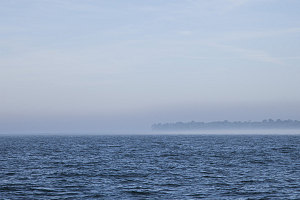
courtesy RHanel
The relatively light winds and the wing-on-wing configuration net us a modest 6-8 km/hr (3-4 knots). It was sufficient for the time being, and benign enough that we could set the autopilot and forget about navigating while we initiated another round of engine debugging.
We took the engine cover off again and inspected more thoroughly, now focusing on the cooling system, which we now knew was part of the problem, given the temperature readings we saw earlier in the morning. I thought back to the low oil pressure of the day before and wonder whether or not the coolant temperature was very high at the time (it may have been and we simply didn't notice). If so, that may have caused an elevated oil temperature and a drop of oil pressure at idle sufficient enough to raise the low pressure alarm (the hotter oil gets, the lower its viscosity, and at idle, when the oil pump is generating the least pressure, it may have been enough to fall below the acceptable threshold). So, maybe it wasn't frothing oil at all, and instead, we had some sort of cooling system issue.
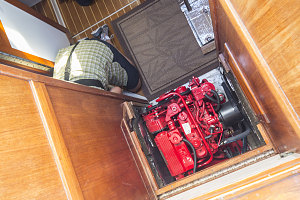
More Engine Debugging
In addition to rechecking fluid levels, we started to understand and examine the engine's cooling system. Essentially, the motor has a pump, driven by a rubber impeller, that sucks water through a hole in the bottom of the hull. It sucks this water up and through a water-to-water heat exchanger that cools the coolant that is being circulated through the engine. The lake (or sea) water that has been passed through the exchanger (and which is now hot) is routed to the back of the boat and merged with the engine's exhaust gases, and then out a port on the stern. Between the inlet port and the impeller is a filter, and this was the subject of our current attention. The filter was made of clear plastic to allow inspection. I instructed Roland to run the engine while I closely watched the filter from below.
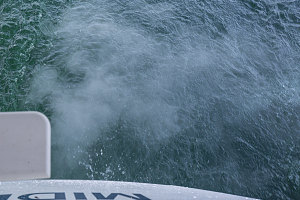
White smoke no good
It did look like there was some flow in the filter as Roland started and revved the engine, but I hadn't looked at it when the engine was operating normally, so I had nothing to compare to. We had a look at the exhaust coming out of the stern, and indeed, it looked strange. Instead of a burbling flow of spitting water out the port, we saw mostly white smoke and little spitting water. This could very well be an indication of poor flow of the lake/sea water circuit of the cooling system.
We debated about what we should do about this problem as we sailed serenely eastward on Lake Erie. The wind swung around to a more southerly direction, enabling us to switch to a more conventional (and faster) sail configuration, and by mid-afternoon, we were once again regularly topping 7-8 knots.
As the day progressed, a new wave of buggy intruders debuted, as a small group of flies began making their presence known. These weren't the typical house-fly type - although they looked somewhat like them. These, instead, were biting flies - and their bite was rather sharp. They seemed smaller than the 'horse flies' that I typically associated with biting. Roland claimed that in Germany these were known as tri-angle flies, or something similar. In any case, we were getting tired with these waves of insects; they had become rather like plagues. Each day for the last three days now, we'd had a different sort of insect-like assault: the midges, the mayflies, and now these buggers. At least the others didn't bite. Out came the swatter, and we spent much of the afternoon in a battle with these skilled little fliers.

courtesy RHanel
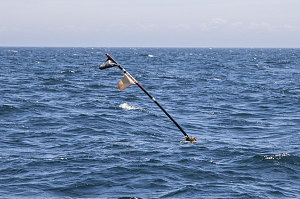
courtesy RHanel
Our northeasterly course towards the next protrusion along Lake Erie's shoreline took us fairly far from shore, and by noon we were far enough away to give us a 360-degree full water horizon view. These Great Lakes are big - even the smallest one. As Roland often says, the Great 'Inland Seas' might be a more appropriate name.
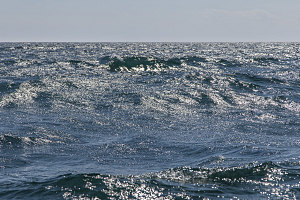
courtesy RHanel
Wave heights increased as the afternoon progressed, and the boat was heaving pretty decently as we slowly approached the shoreline again at a shallow angle. Here the banks of Lake Erie are high, sandy, bluffs. Wind turbines are present along this shoreline, much as they had been for the majority of the lake shorelines we have seen so far on this trip. I had not realized just how many wind power installations there are in Ontario!
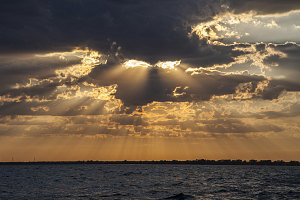
courtesy RHanel
We were generally angling for a huge spit of land sticking out of Lake Erie's northern shore known as Long Point. Roland was thinking that - assuming the winds co-operated - we might be able to reach the end of Long Point and then take shelter on whatever side was opposite the wind. First, though, we had to get to the tip.
The 'Long' in Long Point is an understatement. It is a huge structure, sticking some thirty kilometers out into the lake. I had never really noticed this feature before on a map, but out here, sailing along at less than 10 knots, it took forever to approach its tip. In fact, by the time we finally were within a few nautical miles of it, the sun had set. Only as dusk settled did we finally start to see the long white blink of the Long Point lighthouse.
Roland had been carefully examining the forecast as we approached the tip of Long Point. His assessment was not good - the winds were forecast to remain fairly strong, and to make matters worse, they seemed to be forecast to swing around by more than 180 degrees over the course of the night. This meant that no side of Long Point would be sheltered for anchorage (for the whole night).
As night fell, we nevertheless made an attempt to find a sheltered spot near Long Point's tip, something that would suffice to allow at least a few hours of sleep. After a bit of floundering around in the rough waters and near dark, we decided to switch gears, and just continue on. I was about to experience my first "all-nighter".
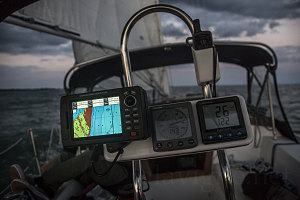
Dusk and a ways to go
Roland's usual modus operandi during night operations was to lower one of the sails, reducing our speed somewhat. It had now become fully dark, and we pretty much could see nothing ahead of us except for navigation lights and the lights along the distant shoreline, so this seemed like a prudent idea.
Our GPSs and boat's chart plotter helped keep us on our northeasterly course, in the general direction of Port Colborne near the eastern end of Lake Erie. The second practice Roland puts into place on overnight sails is a rotating sleep cycle. One of us would go down into the cabin for an hour or two of sleep, and the other would stay up at the helm (or near the helm, if the autopilot was running). Then, we'd switch and repeat. And repeat. And repeat until sunrise.
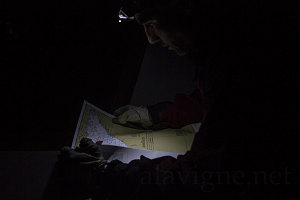
Course of action
So it went, with
Simply Blue coursing across the dark waters of Lake Erie as we fitfully grabbed 60-minute chunks of sleep. I was at the helm at roughly 5 a.m., when a low-clouded dawn sky began to lighten. Captain Roland later fancifully recounted our overnight experience thusly:
"It is utterly haunting to be out in the middle of the lake as the crimson sky bleeds to black. Night reigns. The only light comes from the reassuring glow of the instruments, the pale smudge of distant cities, and the stars above. Love the chilling, forlorn feeling of ripping through unseen swells far out in a dark sea. Raw, intense, wild."
Click below to watch a video wrap-up for June 27:
Video wrap-up for June 27
The all-nighter had indeed been rather exhausting, and it had been quite difficult to maintain wakefulness while on watch. But it had gone successfully, and as a reward, we had made continuous progress all night, and were now significantly closer to the eastern end of the lake. In fact, at this rate, it appeared that we might make Port Colborne before noon, which would be - according to our calculations - a full day ahead of our planned arrival.

Captain at Nav Station
Port Colborne would mark the end of our time on Lake Erie, for this was where we would enter the Welland Canal - our passageway past the waters of the Niagara River to lake Ontario.
The thought of the Welland Canal - a major bit of industrial-strength infrastructure that is part of the Great Lakes Seaway system - caused us to think of our engine troubles once more. In the Welland Canal, we would not be able to sail, and we'd be forced to run the entire 40-ish kilometre length under engine power. If we were stuck with a troublesome engine, it could cause us to run into trouble at an inopportune moment - or worse - strand us in the canal.

Port Colborne Ahead
As we approached Port Colborne - whose large lakeside structures we could now see on the far horizon - we decided to do another engine test, to more fully characterize the problem. While still under sail, we ran the engine at an rpm consistent with a typical cruise situation, such as we'd have to do in the Welland Canal. In very short order the temperature gauge crept up past the 160 degree mark, inching ever closer to the red tick at 212. We began pulling back on the throttle to see if that would reduce the rate of rise, and sure enough, it did. The temperature kept rising, but more slowly.
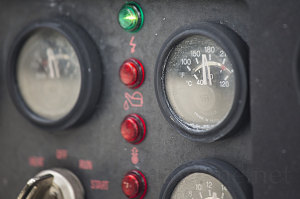
Temp still a problem
We kept pulling back on the throttle until we were down to 1200 rpm, a fairly low power output that wasn't all that high above idle. At that speed, the coolant temperature stabilized. It was still relatively high, but it was no longer trending towards overheating. We concluded from this that the coolant system was working, just not working well.
The problem was, the power output at 1200 rpm was too low for us to achieve the required speeds in the canal, where it is important to follow the instructions that marshall watercraft into, out of, and between locks. And if we pushed the power output higher, we risked running the engine's temperature into the red.
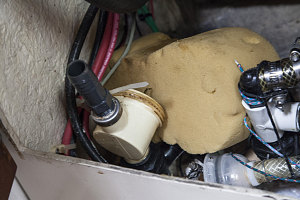
courtesy RHanel
More detaile exploration
It had become clear that our engine issues needed to be fixed before entering the canal. There was a full marina with mechanic at Port Colborne, and we resolved to check in there before heading into the canal. But first, we were going to do one final attempt to debug the problem ourselves. We pulled into the east side of Gravelly Bay, just outside Port Colborne, and dropped the anchor.
Next, we closed the seacock connecting to the cooling intake port and then took apart the inline filter between the inlet and the engine. It did have a significant amount of slimy weeds and - get this - mayfly bodies - in it. Clearly our steaming through the mayfly-matted waters of Lake St Clair and the Detroit River had caused much of this. They may not have assaulted us directly, but the mayfly swarm did give us a nip - in the mechanical issues department.
After cleaning out the filter, we re-installed it, then did a test by briefly opening the inlet seacock without connecting the other end of the filter to the engine. We expected to see a gush of water come through, but it was barely a trickle. Alarmed and dismayed, we realized that there was another blockage, somewhere between the inlet port and the filter. It was clear that someone (erm... the Captain) would need to get wet.
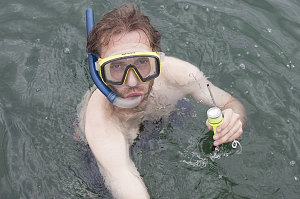
courtesy RHanel
Ready for expedition
Armed with a brush, screwdriver, and a crude hooked wire tool, Roland dipped into the [very frigid] waters of Lake Erie (much colder than sheltered Rondeau Harbour, Roland reported) and disappeared under the boat. We had agreed on a system where he would tap the bottom of the hull while I opened the seacock from the inside; this way, he could poke his tools all the way up to the filter, hopefully dislodging/grabbing as much debris as possible. It took us a few attempts to coordinate, but eventually I could feel his tools work their way all the way up the inlet pipe. Nearly immediately, water began gushing out of the open filter, and I quickly closed the seacock. Major progress!
I reported the success to Roland as he shivered his way back up onto the boat and dried off. It appeared that we had significantly cleared out the path from inlet to beyond the filter, and we were hopeful that this meant that we had eliminated all of the blockages. Next, we needed to run a test. We carefully reconnected the coolant line from the filter to the engine, reassembled the filter itself, and clamped everything tight.
We pulled the anchor, started up the engine, and motored a ways out into the Lake at higher and higher engine speeds (all the way up to 3000 rpm). Immediately things seemed better - there was no more white smoke coming out the back, and there was clearly more burbling water coming out of the exhaust port. The temperature gauge seemed to be moving more slowly, although the engine didn't get a chance to run for too long at high speed before we had to throttle back as we made for the nearby Sugarloaf Marina (we needed to do a fuel fillup before entering the canal). Still, we were cautiously optimistic.
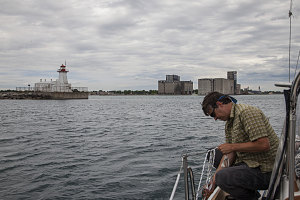
courtesy RHanel